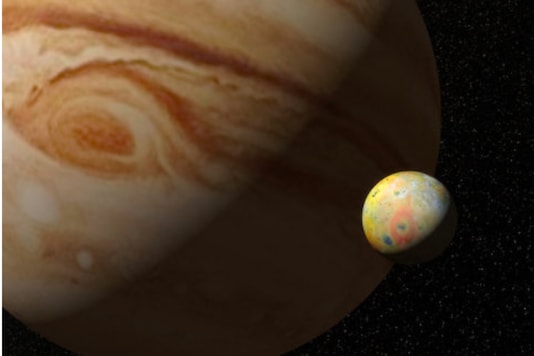Recent Radio Images Show How Volcanic Activity Looks Like On Jupiter's Moon

Illustration of moon Io, with Jupiter in background (stock image). Credit: © Luca Oleastri / stock.adobe.com
With ALMA's magnificent resolution and sensitivity, the astronomers could clearly see the plumes of sulphur dioxide and sulphur monoxide released from the volcanoes for the first time.
- Trending Desk
- Last Updated: October 22, 2020, 13:58 IST
- FOLLOW US ON:
Radio images captured by Atacama Large Millimeter/submillimeter Array have provided scientists for the first time with the direct effect of volcanic activity on the atmosphere of Jupiter's moon Io.
With more than 400 active volcanoes on its surface, Io is the most volcanically active moon in our solar system spewing out sulphur gases that give Io its yellow-white-orange-red colours when they freeze out on its surface.
Even though Io’s atmosphere is about a billion times thinner than Earth's atmosphere, its atmosphere can provide scientists with a window into the exotic moon's interior and what is happening below its colourful crust.
Earlier research has shown that Io's atmosphere mostly consists of sulphur dioxide gas which is ultimately sourced from volcanic activity. However, Imke de Pater of the University of California, Berkeley, says that it is not known which process drives the dynamics in Io's atmosphere. It is still not confirmed if it is the volcanic activity or gas that has sublimated from the icy surface when Io is in sunlight.
Therefore, in order to distinguish between the different processes that give rise to Io's atmosphere, a team of astronomers used ALMA to make snapshots of the moon when it passed in and out of Jupiter's shadow.
StatiaLuszcz-Cook from Columbia University, New York, explained that when Jupiter's moon passes into its shadow, and is out of direct sunlight, it is too cold for sulphur dioxide gas, and condenses onto Io's surface. During that time, the scientists can only see volcanically-sourced sulphur dioxide and therefore can see exactly how much of the atmosphere is impacted by volcanic activity.
With ALMA's magnificent resolution and sensitivity, the astronomers could clearly see the plumes of sulphur dioxide and sulphur monoxide released from the volcanoes for the first time. With the help of the radio images, they calculated that active volcanoes directly produce 30-50 percent of Io's atmosphere.
The images also showed a third gas being released, potassium chloride, which is evidence that the magma reservoirs are different under different volcanoes.
The images were studied by the National Radio Astronomy Observatory which is a facility of the National Science Foundation of the US, operated under cooperative agreement by Associated Universities, Inc.
The research "ALMA Observations of Io Going into and Coming out of Eclipse" will be published in The Planetary Science Journal.









